A technical look at Balsa strength as a function of density.
Click to Enlarge Images
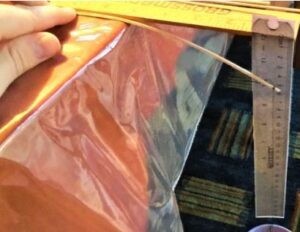
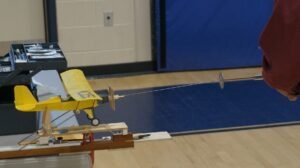
Next Indoor Meet March 12
Hi gang, we’ve got a double feature of sorts for you this time.
The indoor flying season is at a peak with lots of great flying both at the Penn Brook School in Georgetown, MA and the Glastonbury High School in CT. Click the images at left to check out the Feb 5 Georgetown meet. The competition remains very close with enough surprises thrown in (midair collisions, rafter hangups, etc.) to keep things interesting. We’ll share some highlights below.
On top of that, we’ve got a nice article on Balsa Strength by our own engineer-in-training William S. Those of us not familiar with Young’s Modulus need to click the link below and learn something new. And we look forward to hearing thoughts from our seasoned Stealth Sqdn engineers – oh yes, we have a few and they’re not shy!
Back to the Feb 5 flying… Well, William not only knows his tech, he knows how to fly models too! His Earhart Vega and Time Flies embryo were back in the winners circle. Pop George also stretched the winning streak with his Typhoon (WW2 combat) and edged out Sam B’s circle burning Bird Dog with his own steady circling Guillow’s Bird Dog. Still, if it weren’t for a few cut pylons and a controversial mid flight collision with George’s body as the final minutes ticked down, the finish might have been different. The spectators certainly enjoyed the show!
Ray H hung his top-placing Pussycat up in the curtain which opened the door for Sam B and Steve K to duke it out in the final heat where Sam eked out the win. Jon C didn’t have quite enough time to tame the trim gremlins in his Pussycat, or he’d have been a factor in the final too.
Ray came back strong, however, putting up tremendous flights with both his Corben Super Ace to win Dime Scale, and his Voisin Hydro to win Pioneer Scale. Both of these models were flying near 2min flights within the confines of a basketball half-court. Truly world-class flying that one needs to see to believe.
Steve Evans was busy detuning the climb in his Mad Maxine embryo and had it skimming the rafters nicely later in the meet.
The WW1 combat event was competitive as ever. Tom N picked the wrong side of the gym to launch his Nungesser Nieuport and Rich Z’s colorful Fokker DVII siezed the opportunity to pull up underneath the little Ni17, flipping it over and sending it to the floor. The Mercedes in the Rittmeister’s dastardly Fokker must’ve thrown a rod as it just couldn’t keep up with Sam B’s slick Ansaldo SVA which emerged victorious in the end.
At least one new Pinkham Stick model was seen flitting about – this one a triplane constructed from the laser cut parts Jon C. donated at the last indoor meet.
The next Georgetown Indoor Meet is March 12 in the Penn Brook School. See you there — and remember to check out the Article below too!
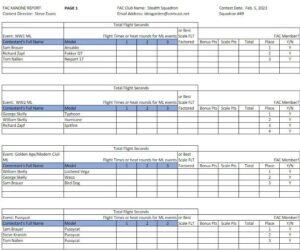
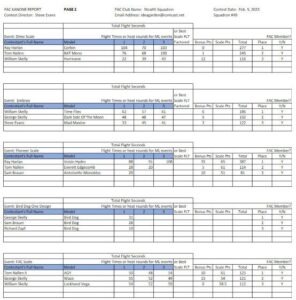
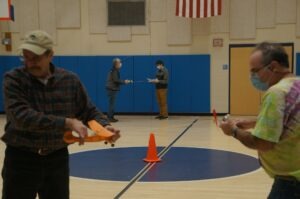
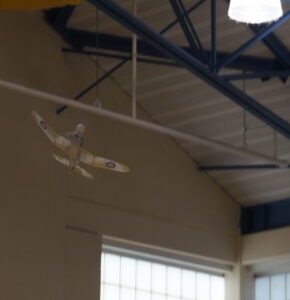
Hi William
You’ve done an excellent job analyzing the modulus of balsa. It’s been a long time since I did that much calculus…
But a couple of suggestions: easy one first-I think the term you’re looking for to describe different properties depending on orientation is “anisotropy”. Metals are isotropic meaning that they have the same properties in every dimension. Composites are anisotropic meaning that their properties depend upon their orientation.
As a chemist, I tend to think of wood as a polymer. Macroscopic polymer properties are dictated by the length of the polymer chains and the number of cross links they have. Long polymer chains without a lot of cross links are pretty flexible- aka rubber. Add more cross links and they get more rigid. Since you’re interested in impact resistance, a long polymer chain without a lot of cross links will be the best bet. Shorter polymer chains won’t be as strong. Of course, defects matter here too. I wouldn’t be surprised if some of these properties are a function of the type of grain of the wood.
Because I think your math took longer than the experiment- I’m going to suggest a different experiment to look at impact. Look at an Instron Impact Tester. Basically it’s a reproducible way to measure the effect of impact on a part- which I’m pretty sure is the problem that interests us. I think you might be able to come up with a simple device based on a swinging weight that will be more informative than simply measuring deflection. Have fun!
Sam
Hi Sam,
Glad you enjoyed the article, and thanks for all the helpful and interesting thoughts. I took a look at that Instron impact testing machine, and it looks really cool, certainly an elegant way to test for crash strength. Be sure to check out part 2, which is now live.
Thanks,
William
Hi William – nice job with the analysis. I learned something new 🙂
I’m interested in your thoughts on this one… Which is preferable for a given modeling application – let’s say a wing leading edge – a larger cross section at a lower density, or a smaller cross-section at a higher density? 1/16 sq @ 6 lb/ft^3, or 1/20 sq at 8lb/ft^3?
thermals,
Tom
Hi Tom, glad you enjoyed the article. The short of it is that for the same weight, a lower density LE with a larger cross-section will be stronger. Check out part 2 for the detailed explanation and calculations. Using the equations from part 2: between a 1/16 sq @ 6 lb/ft^3, or 1/20 sq at 8lb/ft^3, for a plane that weighs 8.31 grams, 2.375″ rib spacing, and impact location 3″ out from the centerline (These parameters are for my dime scale Potez), using the lighter 1/16 sq stick will increase the critical crash speed at which the LE breaks from 6.2mph to 7.3mph. This means that the 1/16″ sq 6 lb/ft^3 stands a better chance against the hoop.
Thermals,
William